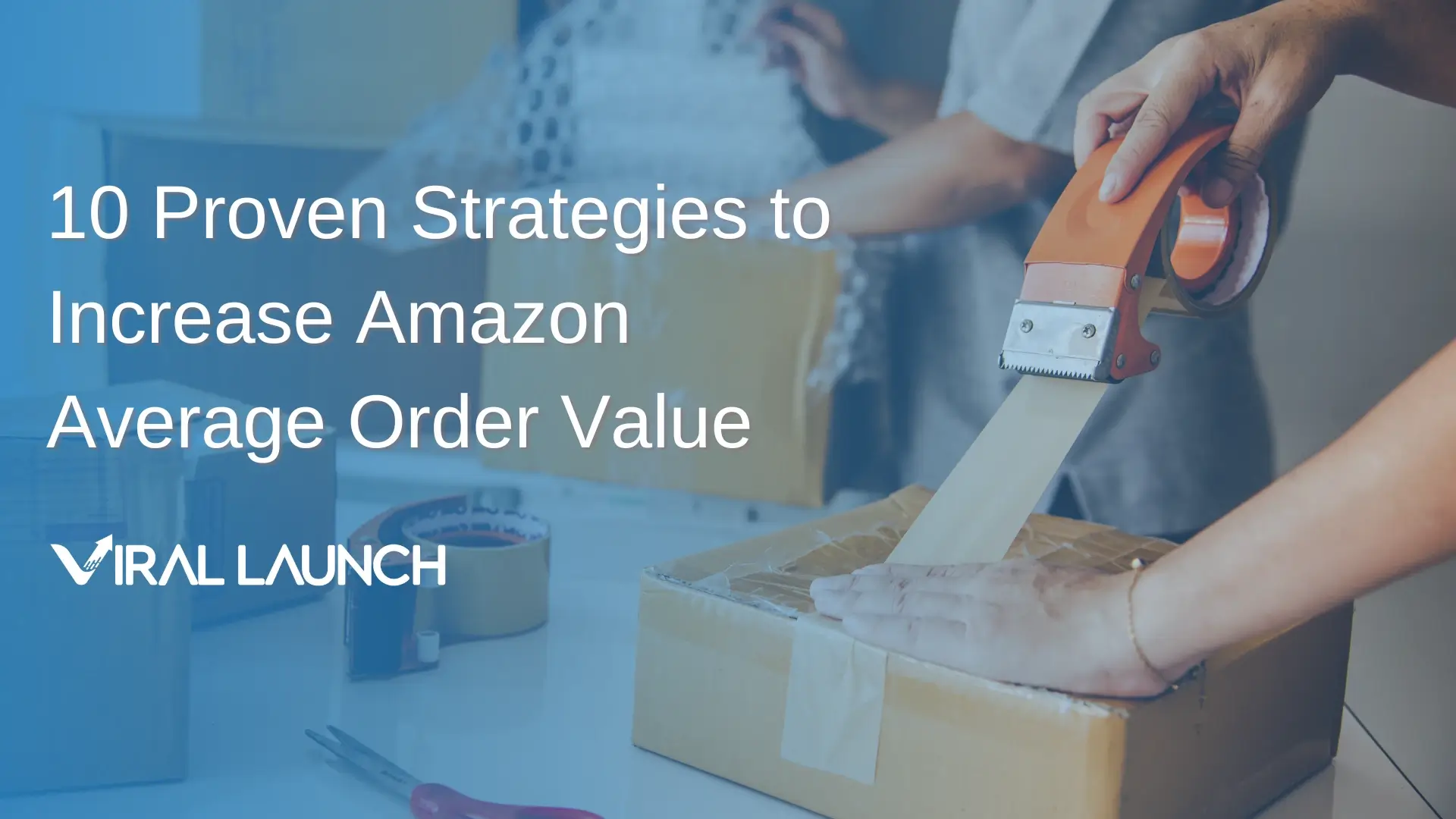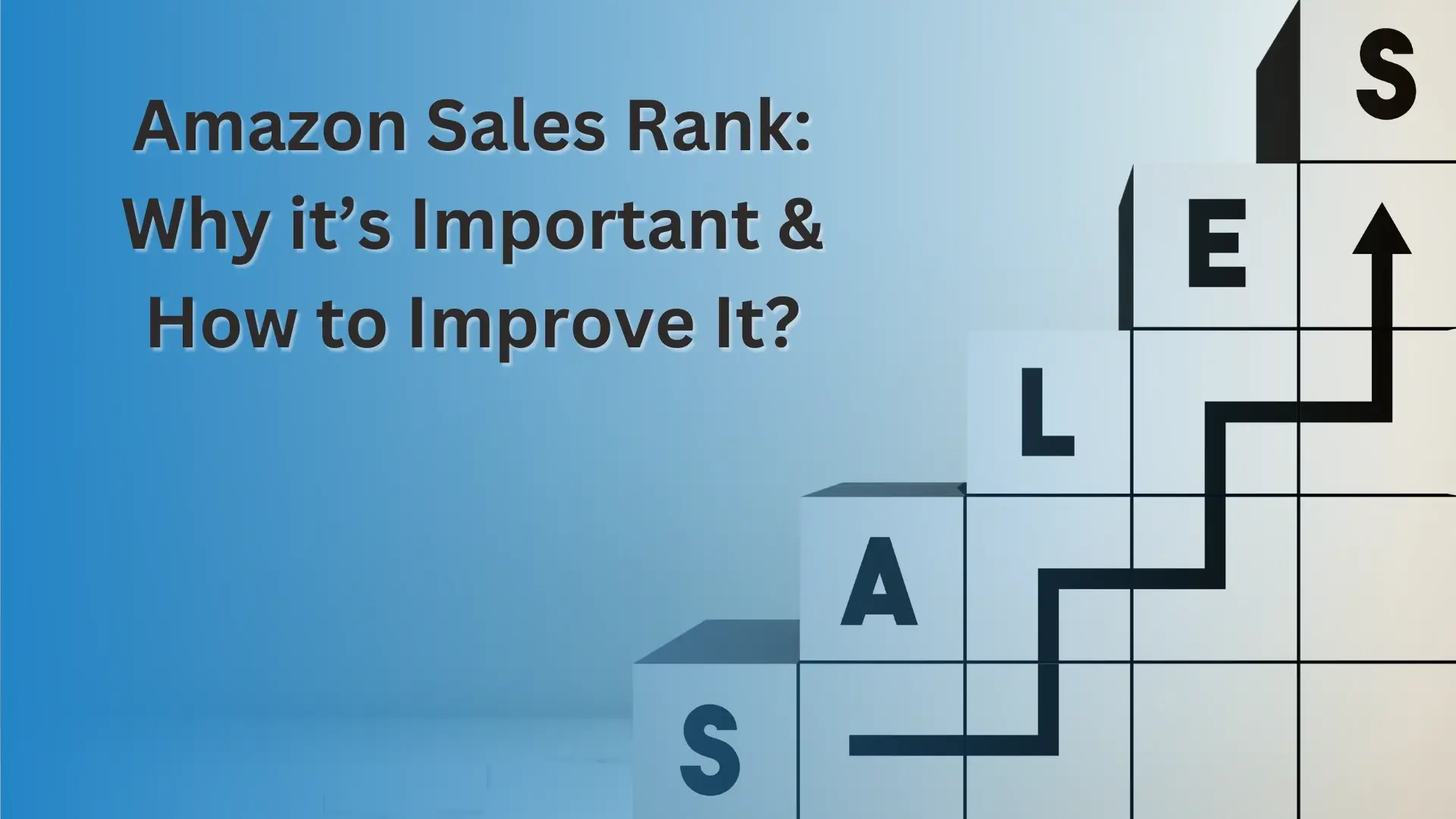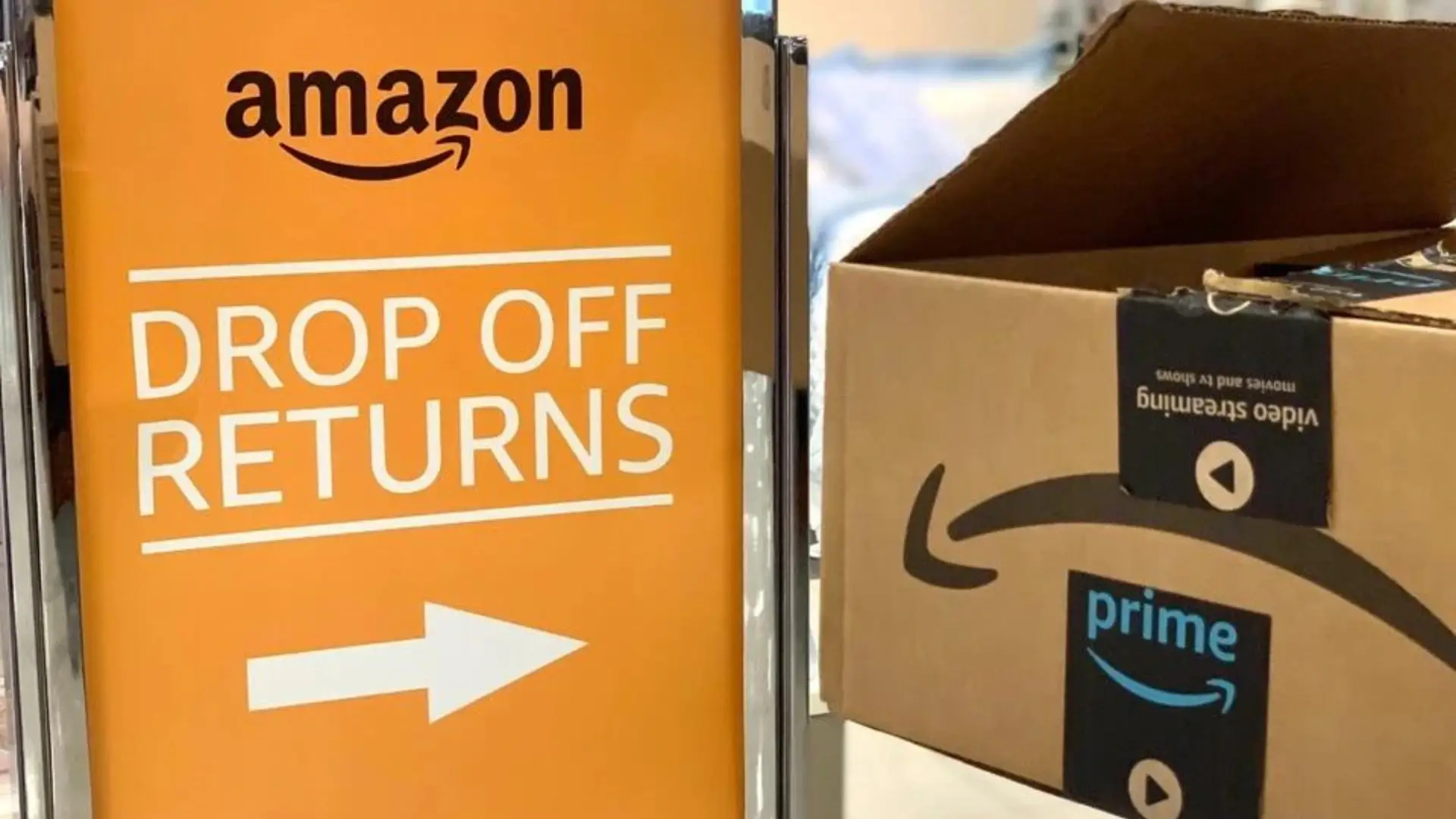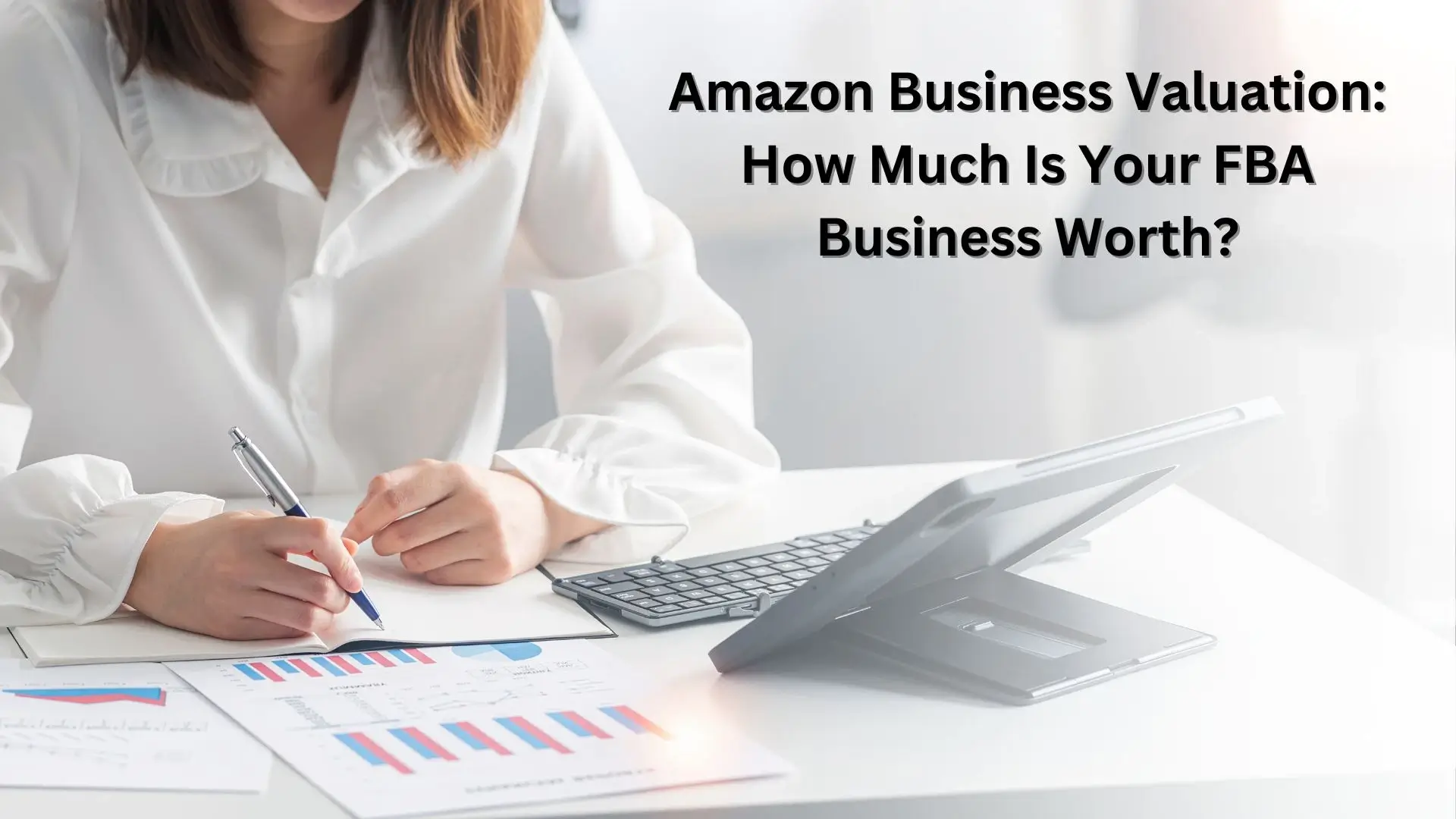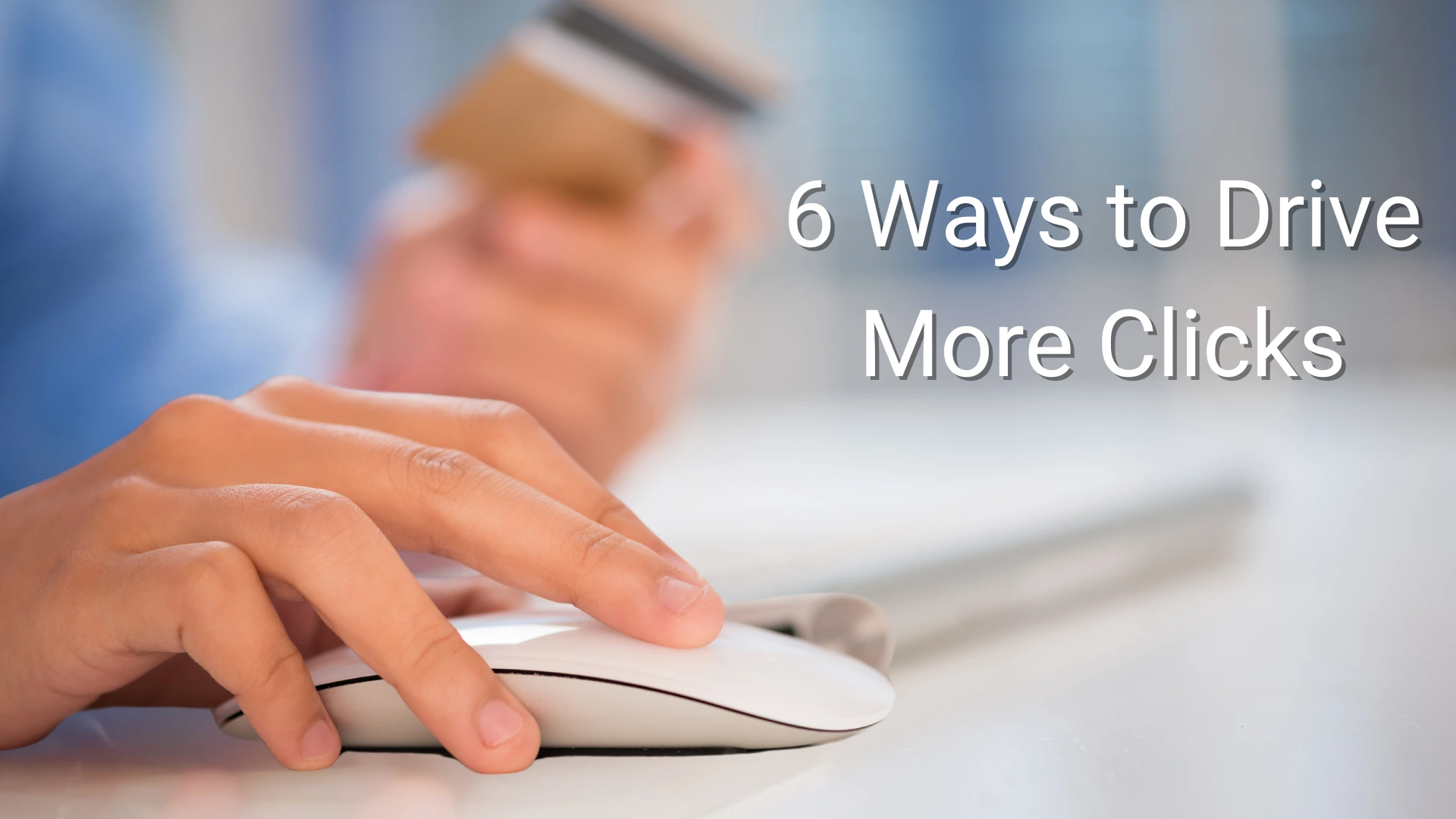Ever considered selling on Amazon? This guide takes you through the essential steps of becoming an Amazon seller, from product selection to optimizing your listings for success.
Amazon is a dominant force in e-commerce that offers significant opportunity for sellers to reach a global audience. Selling on Amazon requires understanding its competitive landscape, the commitment of time and resources, and strategic planning. This guide simplifies the process into eight manageable steps, providing insights and tools to help you navigate the journey from a beginner to a successful Amazon entrepreneur. Explore the potential and start your selling journey with confidence.
Here’s what you’ll learn:
- Better understand the significant opportunity of selling on Amazon
- Learn the steps to becoming a successful Amazon seller
- Get insights on product selection, account setup, and optimization
- Discover strategies to maximize your potential and drive sales on Amazon’s platform
Is Selling On Amazon Worth It?
The question that often lingers in the minds of aspiring online entrepreneurs is, “Is selling on Amazon worth it?” It’s a valid inquiry given the potential rewards and challenges of establishing a presence on the world’s largest e-commerce platform. To make an informed decision, one must consider various factors such as the market’s competitiveness, the time and effort required, and the potential financial returns.
Let’s delve into this question and explore the key aspects that can help you understand the appeal of selling on Amazon and use that to determine whether the journey of selling products on Amazon is truly worthwhile for you.
Amazon’s retail e-commerce dominance
In our increasingly digital world, e-commerce has opened up the global marketplace like never before. Unlike opening a brick-and-mortar shop in your local shopping center, an e-commerce business becomes open 24/7/365 all over the globe. While e-commerce’s origin dates back as early as 1982, it wasn’t until the mid-to-late ’90s that online retail began to make waves with the public.
Amazon and eBay launched online marketplaces in 1995, and how we shop has never been the same. Gradually, more and more consumers recognized the ease and expansive reach of e-commerce, and before long, buying items online became commonplace and the preferred method of shopping for many.
Over the decades, e-commerce has steadily grown in volume. In 2023, 20.8% ($6.31 trillion) of all retail purchases are expected to occur online. And that piece of the retail pie is expected to grow larger for the foreseeable future as millennials and Gen Z become a larger segment of the buying population.
Those numbers speak to the strength of e-commerce, but why Amazon? Well, Amazon doesn’t just lead the pack among online marketplaces; it dominates. As of August 2023, Amazon boasts nearly 50% of the e-commerce market in the United States. Amazon’s primary competitors, eBay (6.6%), Apple (3.9%), and Walmart (3.7%), could join forces and still not come close to overtaking Amazon’s top spot in e-commerce.
A Massive, Loyal Customer Base
“Meet your customers where they are.”
The best businesses go where their customers are, not the other way around. And based on the numbers, when people go to shop online, they overwhelmingly go to Amazon. In 2022, Amazon reported 168.5 million U.S. Prime subscribers. Analysts project that number to grow to 180 million by the end of 2024.
These customers are heavily incentivized and invested on purchasing on the Amazon marketplace. This enormous audience has their payment already plugged into their account and they’re ready to buy items with just a few clicks. If Amazon were a supermarket, it would be crowded with a sea of customers with their cards out ready to pay. For business owners, an audience of this size with buying intent presents opportunities that are almost unfathomable outside of Amazon.
If you want to set up a shop in digital real estate, the choice is clear: Amazon is the place to be for online businesses.
A Built-In Service Tailor Made for Entrepreneurs
In addition to its e-commerce popularity, Amazon makes it easy for online business owners through its Fulfillment by Amazon (FBA) service. Amazon describes the FBA program and its benefits below:
Fulfillment by Amazon (FBA) is a service that allows you to outsource order fulfillment to Amazon. Sign up for Amazon FBA to send products to Amazon’s global network of fulfillment centers and offer customers free, two-day shipping through Prime. When a customer makes a purchase, Amazon fulfillment specialists can pick, pack, and ship the order. We can also provide customer service and process returns for those orders.
To sum it up, Amazon allows you to outsource difficult, expensive, time-consuming aspects of running a business for a fee. The service streamlines the behind-the-scenes work to simplify the work, while eliminating much of the risk and inconveniences you’d face if you chose to sell products on Shopify, eBay, or in a brick-and-mortar environment.
Simply put, Amazon makes it as easy as possible for shoppers to shop and sellers to sell, creating the ideal marketplace for both parties.
8 Easy Steps To Start Selling On Amazon
The good news is that getting started is not as complex as it might seem. In fact, we’ve broken it down into eight easy-to-follow steps that will take you from having an idea to becoming a full-fledged Amazon seller. So, if you’re ready to turn your entrepreneurial dreams into reality, let’s dive right into the eight simple steps to kickstart your journey and become an Amazon seller.
1. Find a Product to Sell on Amazon
Now that you’ve decided to sell on Amazon, your first step is determining what you want to sell. The research you conduct at this initial stage is one of the most important tasks in this entire process. The data you gather and the product choices you make from that data will determine the success or failure of your entire project.
Finding promising opportunities depends on more than imitating the success of a popular product or competing against products with mediocre Amazon product pages. You’ll need to thoroughly research the products, competition, keywords, and market trends before deciding.
Before formulating ideas, be aware of the various selling methods on Amazon. Consider your situation and resources when deciding which selling method makes the most sense for you.
Methods of Selling
- Retail arbitrage is generally a great starting point for an Amazon newbie. Otherwise known as RA, retail arbitrage is when you visit retail stores such as Walmart or Target, buy discounted products, and then resell them on Amazon at a higher price. What’s great about this technique is you can get your feet wet selling on Amazon without a huge investment upfront. Online arbitrage is the same idea, only that sellers buy discounted products online and resell them on Amazon.
- Private label is perhaps the most scalable model for selling on Amazon. With private label, you find a generic product and a manufacturer who can make the product in bulk at a cheap price. Then you tweak the product, add your logo and business information, and sell it under your own brand.
- Wholesale means you buy products directly from a major brand (such as Nike, L’Oréal, or Fisher-Price) at wholesale price and sell them on Amazon. The difference between this and private label is that with wholesale, you’re buying products directly from an already established brand and then selling them under their brand name with their approval.
This guide specifically deals with private label, since it’s the most scalable, while still being a viable option for a newer seller. Your first step to getting started with private label is to start brainstorming product ideas. The possibilities are endless, but you can’t pick a product randomly and expect to make money. The best method for finding the best product ideas is to use data. Doing so will help you identify products with existing demand, which results in high sales potential for you. To gather this data, your best option is to use product-finding software with market analysis capabilities.
Our favorite Amazon product research tool is Product Discovery. This tool provides you with a list of product ideas that match your budget and sales goals. With a few simple filters, you can easily locate product markets where you can compete as a new seller.
If this is your first product, your market criteria should look something like this:
- Decent revenue: We suggest a range of $10,000-$25,000
- Low reviews: We suggest a maximum of 250 reviews
- Search volume: We suggest a minimum of 5,000 searches
- Sales to review ratio: We suggest a minimum of 3 (This means the average monthly sales are at least 3x the number of average reviews. Reviews are the toughest barrier to entry in a market, so you want to make sure you have plenty of sales opportunities to gather reviews and compete with existing sellers.)
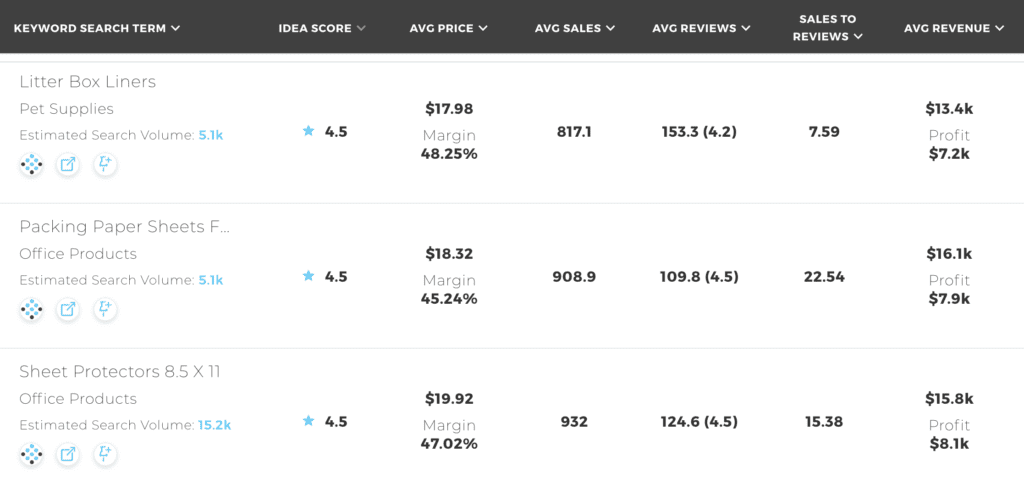
These criteria are just a starting point, and you should customize them to your own goals. The more personalized your inputs, the better your results will be!
After gathering a list of products you’re interested in, you’ll need to validate your ideas. Again, you must use accurate data to ensure you’re choosing a product that sets you up for success. Market Intelligence integrates with Product Discovery, so you can dive right into the validation stage. This process helps you avoid oversaturated markets or markets where your sales potential is low. When you plug your ideas into Market Intelligence, you should analyze the following:
- Barrier to entry: How easy will it be to enter a market and compete with the existing brands? If there are already many established, successful brands with high sales and many customer reviews, your chance of success will be low. The ideal market for new sellers features low competition and high demand.
- Revenue and profit potential: How much can you make with this product? The ultimate measure of how well a business performs is profit, and each business will have different goals. In Market Intelligence, you’ll see how much each existing product makes per month, which will help you determine how much you can expect to make once the product is up and running. Remember to look at market averages, not just a few outliers, so you can accurately predict revenue. And don’t forget: you will encounter costs such as manufacturing, shipping, and Amazon fees. (We added a cost calculator to help with this).
- Monthly sales: How many units are sold each month? To understand how many products you need to order from the manufacturer (which is typically in China and leads to long shipping times), it’s important to know how much demand for this product currently exists on Amazon. Look at how many units are sold each month for products on the first few pages for the product’s main keywords, keeping in mind that you’ll likely need to order at least 2 months’ worth upfront.
- Market trends: How does this product sell throughout the year? Certain markets are seasonal and see spikes in sales during certain times of the year related to holidays or seasonal changes. You’ll need to anticipate these trends for inventory management reasons, and if this seasonality doesn’t appeal to you, it would be best to avoid products that depend on demand at certain times of the year.
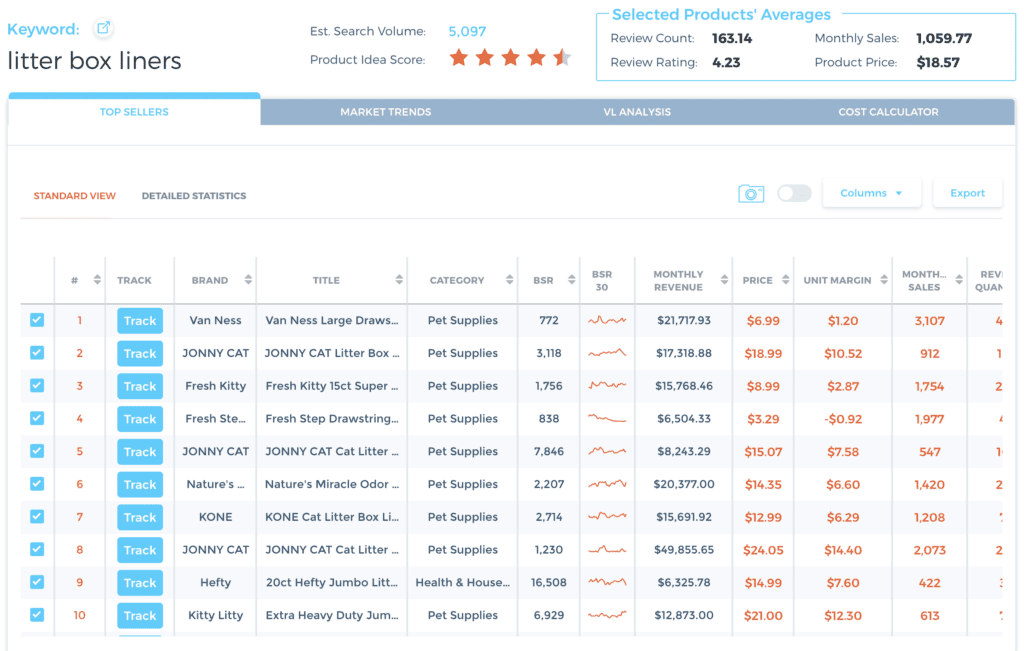

The Amazon marketplace can be overwhelming, especially to newer sellers, but by using software like this to gather data and help find strong product ideas, you exponentially increase your chances of success and steer clear of common missteps or rookie mistakes. Also, by conducting research with data for Amazon, you can eliminate the guesswork and run your business with confidence.
*Note: Before selecting a product, ensure you can source it for a price that allows for a healthy margin. Use a site like Alibaba.com to get an initial idea of how much you will have to spend per unit, and don’t forget to account for shipping.
If you’re ready to find the ideal product for your Amazon business, sign up for a free trial. You can find 25 product ideas and validate 5 of them for free! Have questions about getting started on Amazon? Contact our team anytime and we’d be happy to assist you.
2. Open an Amazon Account
Once you’ve chosen a product to sell, make it official and open a Seller Central account, which will be the hub of your online business. This portal is where you’ll add product listings, manage inventory, view reports, and more. You can open this on desktop or on the official Amazon Seller app.
You’ll start by signing up with a valid email address and then be prompted to add the following information. Make sure you have all the info you need on hand to make the process a little smoother:
- Business name and address
- Telephone number
- Credit card/bank information
- Tax information (If you have an LLC, add your EIN. If not, you can use your SSN)
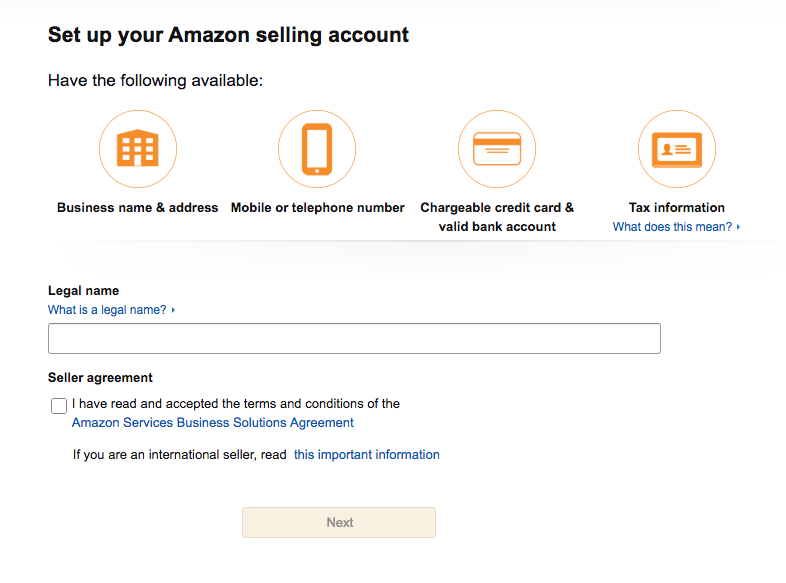

When you start making sales, Amazon will deposit payments directly into your bank account every two weeks. After clicking Next, you’ll enter your billing information. During the signup, you‘ll also choose which account type to sign up for. You have two options regarding how selling on Amazon works:
- Individual: This account type gives you access to 20 product categories and restricts you to a maximum of 40 items sold monthly. You’ll be charged a fee of $1 per item sold, although there is no monthly subscription fee.
- Professional: With this option, you’ll have access to 30 product categories and are eligible, upon approval from Amazon, to sell in the additional restricted categories. This account costs $39.99 per month.
If you’re just looking to sell off some old books, you’ll probably want an Individual account. If you plan to flip items through Retail Arbitrage, you must decide how ambitious you want to be. A Professional account will be best if you plan to sell more than 40 products monthly. As a brand-new seller, there’s no need to pay $39.99 a month until you’re actually selling your product. Just before your inventory arrives at the warehouse, you can easily switch over to the Professional plan.
3. Choose Your Fulfillment Method
The next step is to choose the method of fulfillment for your products. Fulfillment refers to the responsibilities of storing, picking, packing, and shipping products to customers. The two options are Fulfillment by Amazon (FBA) and Fulfillment by Merchant (FBM):
- FBA: This method can be best defined using Amazon’s terms: “You sell it. We ship it.” Using the FBA model, you send your products to be stored in an Amazon fulfillment center. Then, Amazon will pick, pack, and ship your products when a customers order. Amazon also takes care of customer service issues, such as returns. It’s an easy-to-use, hands-off model, but it’s important to know that additional fees are involved.
- FBM: Using this method, you list your products on Amazon and handle all aspects of storage and order fulfillment. You are also responsible for any late, missing, or damaged packages.
The infographic below outlines the pros and cons of each selling method. For a more in-depth comparison, check out our blog article, FBA vs. FBM: A Full Comparison for Amazon Sellers.
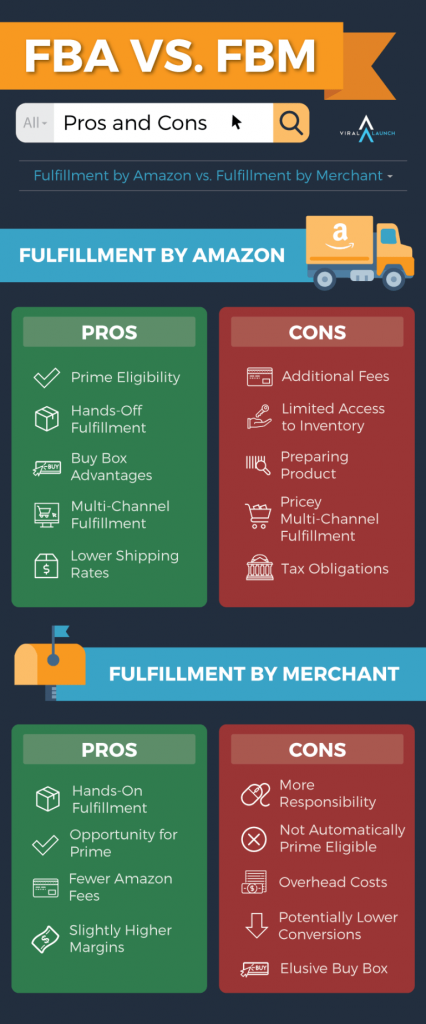

4. Create Your Amazon Listing
In this step, you’ll log into Amazon Seller Central and create your product listing, the page where a shopper will learn about and purchase your product. A product listing is your opportunity to show consumers what your product is, what it does, and why they should buy it. It’s important to be as accurate as possible when describing your product. Include all the necessary information, including ingredients, materials, and dimensions.
What this looks like on Amazon:
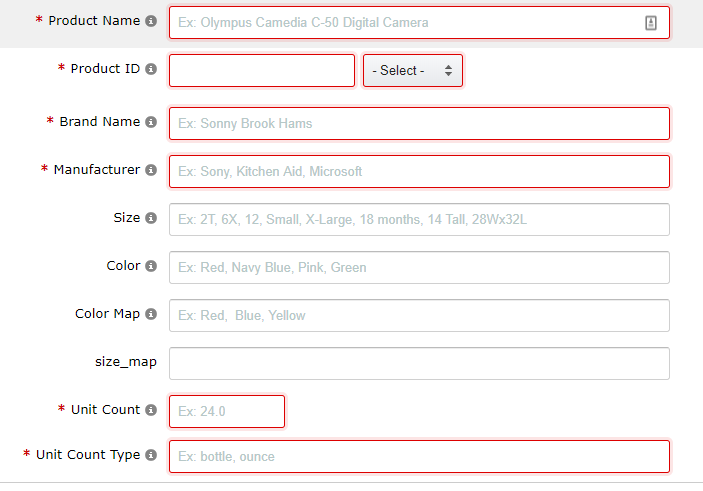

To have your product listed on Amazon, you’ll need to be assigned a specific product number from Amazon, known as a Fulfillment Network Stock Keeping Unit (FNSKU). However, to acquire one, you’ll first need to get a universal product code (UPC), which is a bar code. UPCs are created by the standards organization, GS1 US, and you can obtain your product’s UPC from their website. To get your FNSKU process started, you’ll need to obtain a UPC, which can take some time. Then once you’ve received it, you can create your product listing on Amazon.
The most crucial element in a listing is the keywords, and the effectiveness of your listing depends on your deployment of them. You could write some great copy for your listing, but if you haven’t included the keywords people are using to search for your type of product, your listing won’t be found. In a later step, you’ll ensure your listing is optimized with top keywords to earn strong organic search results and draw traffic. For now, let’s get acquainted with the bare essentials of creating a listing.
A product listing consists of the following elements:
- Title: The title is the most important element in your listing since it’s what Amazon focuses on the most regarding keyword ranking. In addition to your main photo, the title is what shoppers will see first In a search results list. Keep in mind that a title should give an accurate overview of what your product is and does. For some products, this will mean including dimensions or quantity counts. It’s also crucial that you include the most important keywords here.
- Bullet points: In Amazon, these bullet points are known as product features. This is where you can elaborate on and highlight important aspects of your product. This is also where you’ll want to include any important keywords you didn’t fit into your title.
- Product description: Your product description is where you can write in greater detail about your product and expand on what you covered in the bullet point section. Although brevity and keyword placement are key in the title and bullet points, the product description is where you can establish brand voice.
- Backend keywords: This section doesn’t appear on your live listing, so your customers won’t see it. This is where you should input any related keywords you couldn’t fit in the main parts of your listing. You can include foreign-language keywords here along with misspelled words to gain the most visibility.
- Photography: Each listing can have a maximum of nine product photos. The first and most important image in your photo set is called the hero image. This is the main image shoppers see when looking at your product in search results or your listing page. In addition to your hero image, you can add images to show your product in use, known as lifestyle photos. Remember, e-commerce product photography is crucial, as customers can’t feel or see your product in person.
5. Find a Manufacturer
Let’s say you’ve decided to sell private-label products as an FBA seller. Where do you get your inventory? The goal of this step is to answer that question. It’s time to research the potential manufacturers and decide on the best one for your business.
Among the most popular sourcing options for private-label manufacturers is Alibaba. Alibaba is a great place to begin your search for an overseas manufacturer who can supply bulk orders of your product, and is the most popular choice for Amazon sellers when it comes to sourcing products.
When making this choice, make sure you do your research and choose a legitimate company to work with. Alibaba provides its own quality assurance metrics, such as its Verified Supplier and Gold Supplier memberships. These designations are certified by third-party groups outside of Alibaba and confirm the business’s legitimacy. When looking at a supplier’s product page, you can view information that includes their response rate and the number of transactions they’ve had in the last six months.
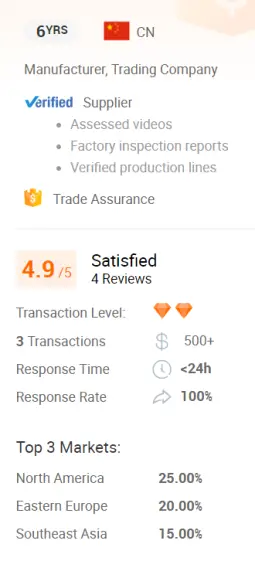

We recommend creating a list of 10 or more suppliers and contacting each of them. Alibaba offers a messaging system for contacting a manufacturer; just click the Contact Supplier button on the product page.
In assessing each one, you’ll be looking for several different characteristics. You’ll want to avoid any language barriers and find someone who will be easy to understand. Pay attention to how quickly a supplier responds to messages. Also, they should provide satisfactory answers to your questions and ask thoughtful questions of their own regarding size, color, and other specifications. It will also be preferable to find an experienced supplier familiar with Amazon’s requirements and seller needs. You’ll also want to know how flexible they’ll be if you need to make changes after placing an order.
Pricing is also a vital point since you’ll want to source a quality product that meets your budget. Once you have prices from each supplier, go to Viral Launch’s FBA calculator to ensure you can make a profit. To estimate your potential profit, you’ll need to know the cost of goods sold, the shipping costs to Amazon, and the selling price of your product on Amazon.
After communicating with each supplier, narrow down your list to two or three and request product samples from each of them. Also, buy some competitor products from Amazon and compare them. It may seem unnecessary, but you’d be surprised at the details you may notice when judiciously reviewing a product. After reviewing everything, you can decide on which supplier to work with.
For more in-depth information about finding a manufacturer, listen to this episode from Viral Launch’s podcast, The Seller’s Edge.
6. Order and Ship Your Product
In the last step, you’ve decided on the best supplier for your product, so now you can place your first full order. We recommend that you order enough product for at least a two-month run of inventory.
Since you’ll be ordering from an overseas supplier, you’ll have a few different payment options.
- Bank wire (or telegraphic transfer): This method is the riskiest since you pay directly to the supplier’s bank account before receiving your order. Of the other methods, this requires the least amount of fees. Manufacturers usually prefer these kinds of payments, but we recommend using a different option, especially when forming a new supplier relationship.
- Credit card/PayPal: This is a more reliable and secure payment method, but it comes with additional fees. Because of the security involved and the ability to cancel a payment, many who sell on Amazon prefer this method. However, due to fees, some manufacturers will not accept these for large orders.
- Escrow service: Alibaba provides this payment option, essentially a combination of the previous two. Your payment is sent to the supplier, but it’s held by Alibaba until you confirm the receipt of your product. This is a great middle-ground; try to find a manufacturer willing to accept Alibaba pay or similar, which protects you and them.
Before paying, you’ll need to plan where your goods will be shipped depending on your selling plan. You’ll also need to provide the supplier with box labels, pallet labels, and FNSKUs.
If you choose FBA, the destination will be one of Amazon’s fulfillment centers. Additionally, you’ll need to notify Amazon that your order is coming by creating an inbound shipment in Seller Central. If you choose FBM, your manufacturer will send your product directly to you or to your desired warehouse. You can work with your manufacturer and a freight forwarder to handle shipping logistics.
Lastly, you’ll want to consider an inspection. You can have a third-party inspection company check over your inventory to make sure it’s up to your standards, either in the country of origin or in the United States. Alibaba has an inspection directory to help you find an affordable provider in the origin country. We recommend an inspection on your first order, with inspections every few orders after that to ensure the highest quality.
7. Optimize Your Listing
In this step, we return to the product listing from Step 4 to do some search engine optimization (SEO). The goal with a listing optimization is to ensure the listing will reach the greatest number of consumers seeking your product. As discussed earlier, using the most relevant keywords will be crucial to creating a listing that earns a high search ranking and draws traffic.
You may have already started gathering the important keywords from the earlier product research step, but if you haven’t, entering your product in Keyword Research will give you a list of the top keywords to include. You’ll want to write a title that artfully incorporates the top keywords without confusing the customer. The following is an example of a well-optimized title for a first aid kit:
First Aid Kit Emergency Preparedness Medical Supplies for Home, Office, School, Car, and Travel – 150-Piece Small Basic Kit with Full Range of Medical Supplies for Treating Common Injuries
It includes vital keywords associated with the product from Keyword Research and lets consumers know exactly what they’d receive upon purchase.
Our Listing Builder tool provides an efficient and simplified way to create a listing, helping you build each element. Enter your title, features/bullet points, product description, and backend keywords, and you’ll generate an optimization score, telling you how effective your listing is. If it needs some work, the score will tell you. You can experiment with your listing by adding keywords and moving them into different sections from the displayed list, and watching the score fluctuate to figure out what works and what doesn’t.
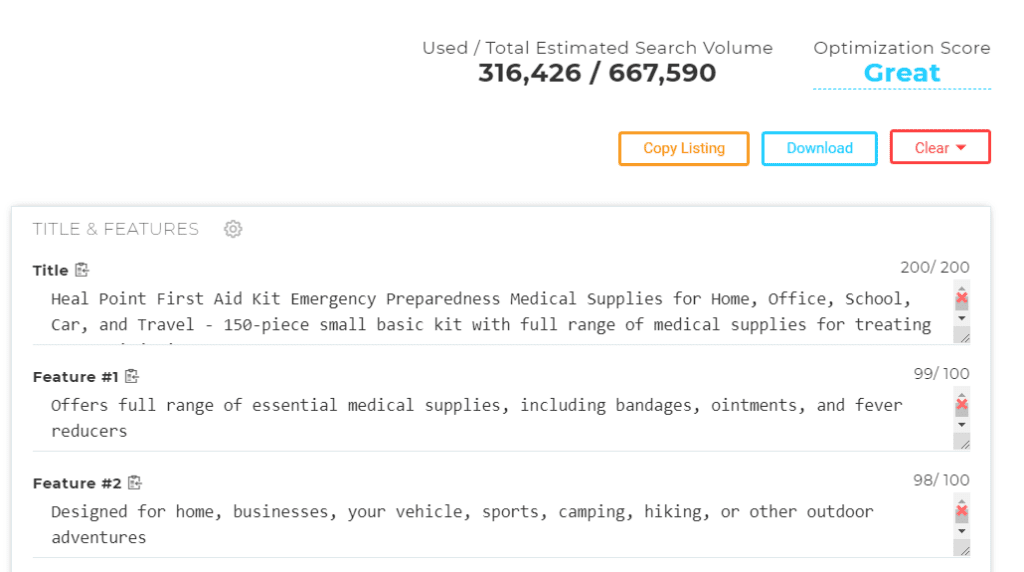

If this sounds too time-consuming or not up your alley, consider LaunchGPT, our AI-powered tool that creates your product listing copy for you! Using Amazon keyword data from our comprehensive set of tools, LaunchGPT takes the basics of your product and strategically generates copy for each segment of your customer-facing listing. It’s like ChatGPT but tailored specifically to the needs of Amazon sellers! Simply provide some basic info about your product, and within minutes, a ready-made product listing is created for you.
When you have a well-optimized listing, copy it into your Amazon seller account and get one step closer to starting an Amazon business. Be sure to check out our in-depth guide on how to optimize your product listing for more!
8. Start Driving Sales
Your business as an Amazon seller officially begins now. Once you have your product listing completed and products ready to ship, it’s time to go live and sell on Amazon.
However, there’s much more to it than just throwing up a product listing and expecting sales to start rolling in. To set yourself up for success, you’ll want to increase your visibility. We recommend a couple of different tactics:
- Running a pay-per-click (PPC) campaign.
- Offering a product giveaway, or what we call a product launch.
PPC Campaigns
PPC campaigns are essentially the “sponsored content” advertisements you’ve probably seen when browsing products on Amazon. In these campaigns, you bid for your advertisement to appear in sponsored ads for a keyword related to your product. When a consumer searches for that keyword, your ad appears and you pay a small amount of money to Amazon for each click your ad receives. This helps generate visibility initially and gets your product in front of more people than you would otherwise.


Product Launches
Another way to get your product more visibility is through product launches. These will help kickstart your listing through deeply discounted sales. This helps Amazon’s algorithm understand your product as important for the keywords in your listing, and the goal is to increase your product’s rank in search. The higher a product ranks on Amazon, the greater your sales opportunity. Most shoppers don’t make it past the first page when browsing, so page-one positions for major keywords are essential.
Your Amazon search results ranking should rise with a launch, providing exposure to consumers and the chance to drive significant sales. Sales and rank both influence each other. As your sales increase, your organic ranking will increase. As a result, this exponentially helps visibility to drive sales and cause your rank to continue to rise.
Want to learn what not to do when launching? Check out our 9 Common Launch Mistakes to Avoid.
Amazon Seller FAQs
If you’re considering entering the world of Amazon selling, you likely have numerous questions about how to get started, what to sell, how to optimize your listings, and much more. In this section, we’ll address some of the frequently asked questions that arise when embarking on your journey as an Amazon seller, providing you with valuable insights and guidance to help you hit the ground running on the platform.
Do I need a business license to sell on Amazon?
No, you do not need to acquire a business license to sell on Amazon.
However, we recommend enrolling in Amazon Brand Registry to enjoy a bevy of benefits for your Amazon business. Enrollment in Brand Registry requires an actively registered or pending trademark for your brand. The Brand Registry program unlocks Enhanced Brand Content, protects your brand from imitators, and a host of other helpful benefits that enhance your Amazon offerings.
But a business license is not among Amazon seller requirements.
Is selling on Amazon free?
Although you do not need to pay anything for a Seller Central account, selling on Amazon isn’t free. Amazon offers a Professional selling plan and an Individual selling plan to sell on its platform. As previously mentioned, the Professional account costs $39.99 per month with no per-item fee and the Individual account doesn’t have an upfront fee but incurs a $0.99 charge for each item sold.
Of course, it does cost to sell on Amazon since it requires money to purchase inventory if you source your products and Amazon seller fees via its FBA program and a per-item referral fee exist. Consider these Amazon selling fees as an investment into your own business.
What is dropshipping?
Drop shipping is a business model where you don’t have to keep any inventory. You simply act as the middleman between your customers and the supplier who stocks the product. This selling method is how to sell on Amazon without inventory on hand.
Whenever you receive an order from a customer, you place the same order with your supplier, and they will ship it directly to your customer. If this sounds appealing to you, please check out our deep dive into how to dropship on Amazon.
How to find products that are in demand on Amazon?
Viral Launch’s Product Discovery tool! Product Discovery has helped hopeful Amazon sellers uncover untapped product markets to reverse engineer top items to sell on Amazon for years. Built on real-time and historical data by tracking Amazon’s full catalog, Product Discovery lets you customize your search by crucial metrics like search volume and sales that can play a vital role in finding in-demand products.
Once you think you’ve unearthed a gem of a winning product idea, validate it with extra data from Market Intelligence to earn the data-informed advantage and proceed with confidence.
What is the average monthly income for Amazon FBA?
Results vary, but according to one poll, nearly half of Amazon third-party sellers make between $1,000 and $25,000 per month. Needless to say, this number relies on pricing, sales, and competition. With no guaranteed sales and no upper limit, there’s a substantial gap in potential monthly income.
Start Selling On Amazon Today
If you’re ready to take the plunge and start selling on Amazon, there’s no time like the present to get started! With its vast customer base, unparalleled infrastructure, and a myriad of resources at your disposal, Amazon offers an incredible platform for aspiring and seasoned entrepreneurs. With determination, a clear plan, and reliable, accurate data on your side, you can turn your business aspirations into a thriving reality.
The reliable and accurate data? That’s where we come in. The Viral Launch software suite boasts solutions for Amazon sellers at all stages. From finding prospective products to sell to creating your product listing to managing your buy box strategy and advertising efforts, Viral Launch gives you the competitive edge with trustworthy data based on years of incessantly tracking the Amazon market.
Start your 14-day free trial to the Viral Launch software suite today to start your Amazon journey with tools trusted by thousands of Amazon sellers. With premium tools and walkthroughs to help you utilize the tools to the best of your ability, our software is tailor-made to help Amazon sellers confidently conquer every step of the selling process.
Starting your Amazon selling journey today begins with just a few simple steps. Each phase brings you closer to your goals, from product selection and account setup to optimizing your listings and engaging with customers. So, don’t wait any longer. The world of e-commerce awaits, and there’s no better time to start than now.


